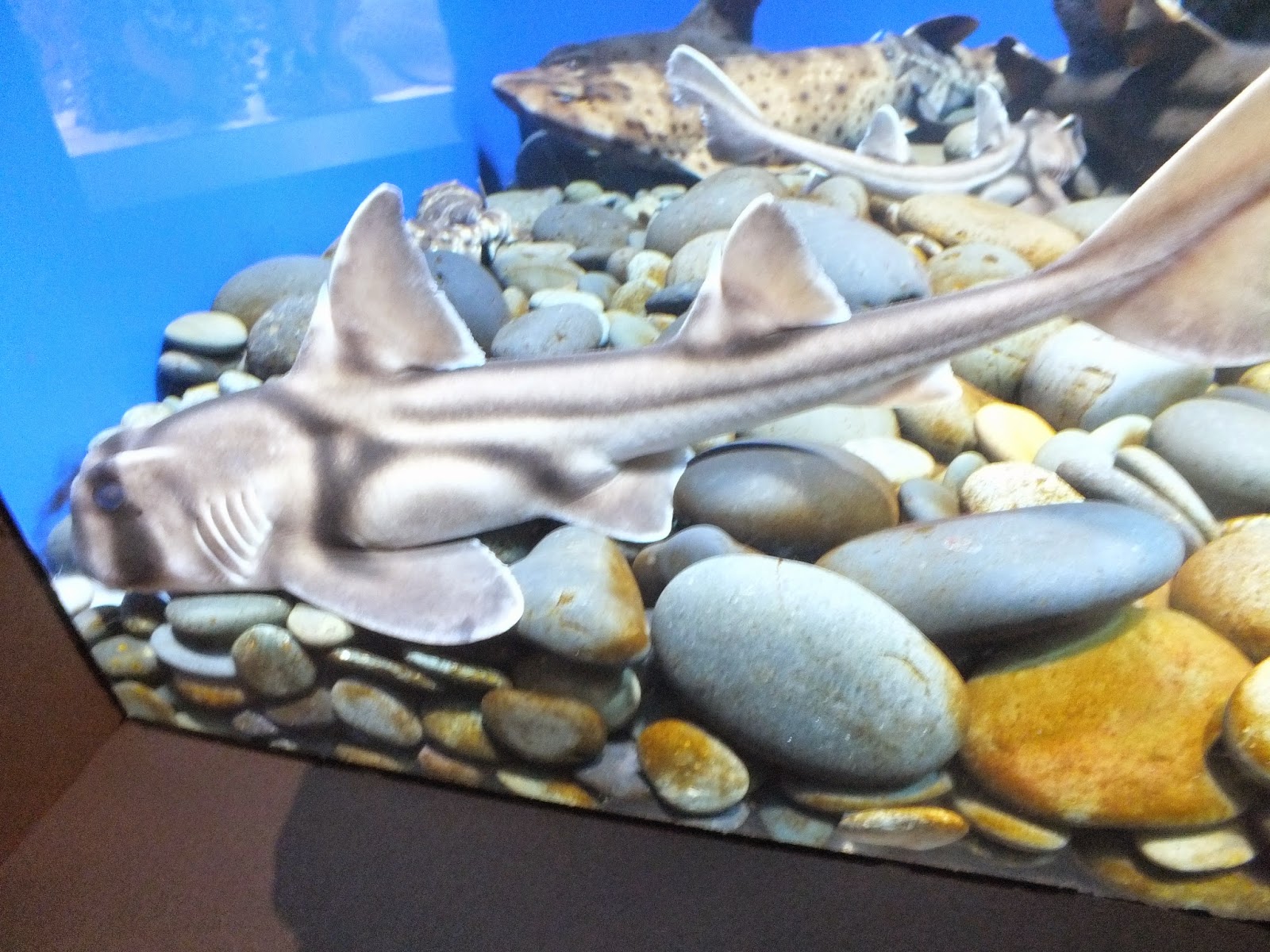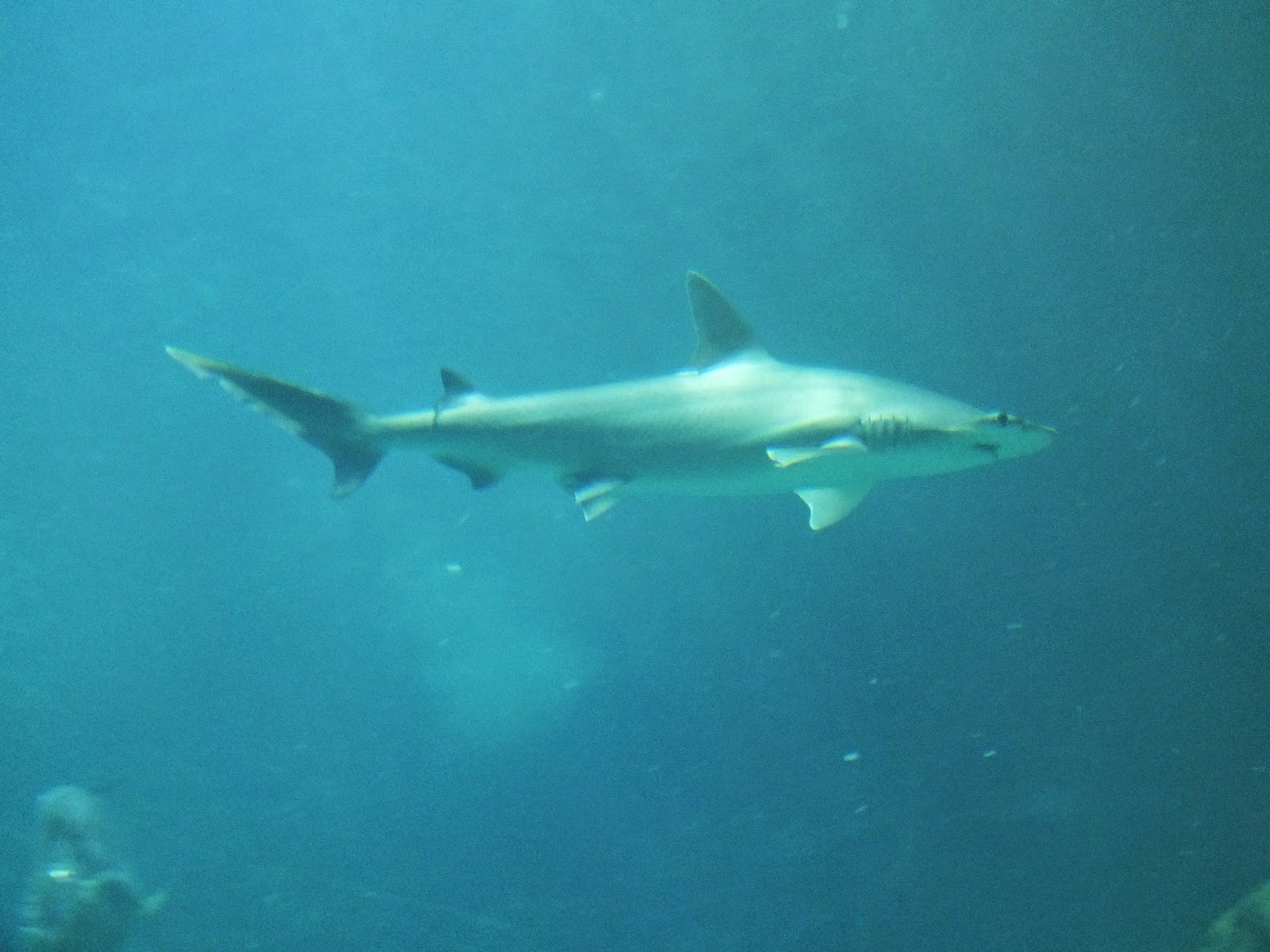When I visited Canada last year, I spent two days in Toronto to see a few of the sights and meet friends and family. I got to Toronto quite late in the day, but decided to head to the CN Tower.
The CN Tower, downtown Toronto, from directly beneath it.
June 2014
I honestly didn't know at the time, because I last visited Toronto in 2002, but there is a new beautiful aquarium at the foot of the tower, that was importantly open until late (something like 11 p.m.). Of course, I went in, not hoping to see very much.
Ripley's Aquarium of Canada, Toronto.
It turns out the Ripley's Aquarium of Canada is the best aquarium I have ever visited. OK, I haven't been to that many, mostly in the UK, but it beats all of them hands down. It has several well designed exhibits with many unusual species of fish and invertebrate that I had not seen before.
All photos taken in June 2014 at Ripley's Aquarium of Canada, Toronto, by the author.
Orange sea pen
Ptilosarcus gurneyi (Gray, 1860)
Pennatulidae; Pennatulacea; Anthozoa; Cnidaria
This bright orange thing looks like an antiquated writing implement sitting in an ink well, and kind of looks like a plant. It is in fact an animal, an invertebrate distantly related to jellyfish and sea anemones. Sea pens have a long fossil record, definitely having existed in the Cambrian, being found in the Burgess Shale (a deposit from western Canada dating to around 500 million years ago), and the enigmatic Ediacaran fossil Charnia masoni from Leicestershire which is even older (c. 580 Ma) might be a sea pen. Like their fellow cnidarians, corals, they are colonial animals, meaning each sea pen is made of thousands of tiny polyps that work together to feed and protect the whole sea pen. They are capable of uprooting themselves and moving, although spend the vast majority of their time in one place.
Arctic grayling
Thymallus arcticus Pallas, 1776
Salmonidae; Salmoniformes; Actinopterygii; Chordata
Grayling are members of the salmon family, and are distributed across the Northern Hemisphere, including Britain. The arctic grayling is found in rivers and lakes across the north of Eurasia and North America. Unlike salmon they never enter the sea, but some populations spawn in tributary streams but spend their lives in lakes.
Nurse shark
Ginglymostoma cirratum (Bonnaterre, 1788)
Ginglymostomatidae; Orectolobiformes; Chondrichthyes; Chordata
The nurse shark is a nocturnal fish that spends most of its day resting on the ocean floor. (I'm writing this as the song "Nightswimming" by R.E.M. just came on my iPod, wow). They eat fish, crustaceans and molluscs, which they can crush with their specialised dentition, which is both sharp and strong. Nurse sharks are found in the tropical western Atlantic Ocean, mainly around the Caribbean, but a population from the eastern Pacific, from Mexico to Peru, has been newly described as a new species, Ginglymostoma unami Moral-Flores et al., 2015 (available here). Interestingly, "young nurse sharks have been observed resting with their snouts pointed upward and their bodies supported off the bottom
on their pectoral fins; this has been interpreted as possibly providing a false shelter for crabs and small fishes that the shark
then ambushes and eats" (Compagno, 1984; available here).
Sandbar shark
Carcharhinus plumbeus (Nardo, 1827)
Carcharhinidae; Carcharhiniformes; Chondrichthyes; Chordata (phew, lots of Cs there!)
This is a widespread shark in subtropical and tropical coastal waters worldwide. It has a similar diet to the nurse shark, eating fish and crabs, and is not considered a danger to people despite its large size. They are unfortunately threatened by fisheries as they present very good fins for the mostly Asian market of shark fins.
Atlantic horseshoe crab
Limulus polyphemus (Linnaeus, 1758)
Limulidae; Xiphosura; Merostomata; Arthropoda
The horseshoe crab is one of those creatures often called a "living fossil". However much you like or dislike this term, you can't deny there's something very prehistoric-looking about them. As a group, the order Xiphosura dates back to the Ordovician period (450 Ma). There are four living species from Asia and North America, and are believed to be the closest living relatives of trilobites, which I have no problem in believing. They come ashore en masse at certain times of the year, an event which can be observed on parts of the Atlantic seaboard in May.
Red lionfish
Pterois volitans (Linnaeus, 1758)
Scorpaenidae; Scorpaeniformes; Actinopterygii; Chordata
Red lionfish are native to the Indo-Pacific region and are one of the most easily recognisable of warm water marine fish. They are poisonous, venomous indeed, as they are capable of injecting their venom through the fin spines. Although extremely painful, lionfish venom is apparently rarely fatal to humans. In recent years, they have become established in the Caribbean Sea and are considered invasive in most of the island nations and coastal parts. In Barbados, they are caught, cleaned, and eaten, although this practice has not spread very far,
Electric eel
Electrophorus electricus (Linnaeus, 1766)
Gymnotidae; Gymnotiformes; Actinopterygii; Chordata
The electric eel is an infamous freshwater fish from South America, known for being able to produce electricity for defence at an incredibly high voltage. It is unrelated to true eels (Anguilliformes), being the largest member of the knifefish family. They produce the electricity using three pairs of organs that make up the vast majority of its body. Like muscle and nerve cells, the individual cells in these organs (electrocytes) are linked to one another to pass electrons to each other, and are stacked to increase the voltage. The duration of the shock is very short and is thus unlikely to kill a human, even at 600V/1A, which is much greater than the voltage/current needed to induce heart defibrillation. The fish is also renowned for its great sense of hearing, and oddly, is an obligate air-breather, as it lacks gills, respiring using the mouth. Another odd fact, the electric eel is one of the few animals known to use social media - an individual at Tennessee Aquarium has its tank linked to Twitter, and a pre-written text is triggered whenever the fish emits electricity of a high enough threshold. Miguel Wattson, as he is known, tells bad aquatic animal related jokes. Not bad for a (non-human) fish though.
Longsnout seahorse
Hippocampus reidi Ginsburg, 1933
Syngnathidae; Syngnathiformes; Actinopterygii; Chordata
The longsnout seahorse dwells in the Caribbean Sea and neighbouring parts of the Atlantic up to North Carolina. It isn't currently considered threatened by the IUCN, as information is insufficient, but it most likely faces the same threats as other seahorses, hunting, collection, and habitat loss.
Leafy sea dragon
Phycodurus eques (Günther, 1865)
Syngnathidae; Syngnathiformes; Actinopterygii; Chordata
The leafy sea dragon is a bizarre relative of seahorses restricted to coastal waters of southern Australia. It blends in so seamlessly with the weedy environment thanks to the growths on its body and its slow moving drifting habits. It moves its tiny fins so rapidly it cannot be seen to move actively at all. It feeds on whatever tiny planktonic creatures can fit into its narrow pipe-like snout, just like seahorses and other pipefishes. Also like seahorses, it is the male that cares for the eggs and young, the former of which he carries around under the tail embedded to his skin.
Weedy sea dragons
Phyllopteryx taeniolatus (Lacepède, 1804)
Syngnathidae; Syngnathiformes; Actinopterygii; Chordata
This is a close relative of the leafy sea dragon, albeit smaller and less ornately decorated with leaves. They are slightly more broadly distributed, extending the range to coastal Tasmania as well as southern Australia. Both are considered Near Threatened by the IUCN.
Spotted wobbegong
Orectolobus maculatus (Bonnaterre, 1788)
Orectolobidae; Orectolobiformes; Chondrichthyes; Chordata
With a name like 'wobbegong', it must be Australian. And this carpet shark doesn't disappoint on that front. It shares a similar range to the sea dragons, extending further up to the southern Barrier Reef.
Epaulette shark
Hemiscyllium ocellatum (Bonnaterre, 1788)
Hemiscylliidae; Orectolobiformes; Chondrichthyes; Chordata
The epaulette shark is named for its rounded eye spots on its shoulder that somewhat resemble military epaulettes. These are probably used for defence. It dwells in very shallow water and is able to cope with the lack of oxygen present in these habitats by shutting down oxygen and nervous supply to non-vital organs.
Zebra shark
Stegostoma fasciatum (Hermann, 1783)
Stegostomatidae; Orectolobiformes; Chondrichthyes; Chordata
Looks decidedly un-zebra like, right? It is the young that are black and white and stripy like their namesakes, changing to brown and spotted as the animal matures. They are another kind of carpet shark from the Indo-Pacific oceans, spending a lot of time on the ocean floor. They eat fish, crustaceans, and molluscs, and are altogether very inoffensive animals, making them much loved by aquaria and divers.
Horn shark
Heterodontus francisci (Girard, 1855)
Heterodontidae; Heterodontiformes; Chondrichthyes; Chordata
Closely related to the Port Jackson shark, the horn shark is from California and western Mexico. The teeth of horn sharks are quite bizarre and un-shark-like. This is because they are mostly broad and flat, used for crushing the hard exoskeletons of molluscs, starfish, sea urchins, and crustaceans. Despite this, they will bite if provoked, but it is the horn spines that give the animal its name that prevent more of a risk to overzealous divers.
Swellsharks
Cephaloscyllium ventriosum (Garman, 1880)
Scyliorhinidae; Carcharhiniformes; Chondrichthyes; Chordata
These small sharks of the eastern Pacific are in the dogfish family, and gain their name from their habit of swelling with water when threatened. The specific epithet, ventriosum, meaning "big belly", is also from this fact. They will also bite their tails to form a ring shape, somewhat like the mythical ouroboros. They, as other dogfish, rise to the surface to release air from their stomachs to make them less buoyant. In so doing, they make a barking noise, hence 'dog fish'. Swellsharks were recently found to be biofluorescent; they can produce light which is likely used for individual recognition by these night-active sharks (Sparks et al., 2014, available here).
Spotted ratfish
Hydrolagus colliei (Lay & Bennett, 1839)
Chimaeridae; Chimaeriformes; Chondrichthyes; Chordata
The ratfish or rabbitfish is a kind of chimaera. In Ancient Greek myth, chimaeras were hybrids of different animals, usually as part lion, part goat, and part snake. Biologically, a chimaera can either be an organism with genetically distinct cells, or a member of the Holocephali - an ancient group of cartilaginous fish related to sharks and rays. The Holocephali extend back to the Devonian period (416 Ma), and are represented now by ratfish, rabbitfish, and other chimaeras. They tend to be somewhat shark-like, with long tails (hence 'ratfish') and large eyes (hence 'rabbitfish'), altogether looking like a hybrid (hence 'chimaera'). The spotted ratfish lives off the coast of the Pacific Northwest of Canada and the U.S.
Bonnethead
Sphyrna tiburo (Linnaeus, 1758)
Sphyrnidae; Carcharhiniformes; Chondrichthyes; Chordata
The bonnethead is a small hammerhead, those sharks with the bizarrely-shaped head. It is found from the southern U.S. to Brazil and Peru, on both sides of Central America. Because of their negative buoyancy (their increased potential to sink), they must keep swimming in order to stay alive, or else oxygen cannot be extracted from the water.
Spotted jellyfish
Mastigias papua Lesson, 1830
Mastigiidae; Rhizostomeae; Scyphozoa; Cnidaria
Looking somewhat like a toadstool wearing a skirt, the spotted jellyfish is native to tropical waters of the Indo-Pacific. This is one of a few species of jellyfish on display at the Aquarium, under artificial blue light.
Thanks for staying with me through this aquatic odyssey! Please check out the social media for updates from me, you can catch me on the book of faces here and on the twitter here. Also, follow Wildlife Articles for more articles from me and many other bloggers around the theme of British wildlife. Next, Toronto Zoo.
Subscribe to:
Post Comments (Atom)






















No comments:
Post a Comment